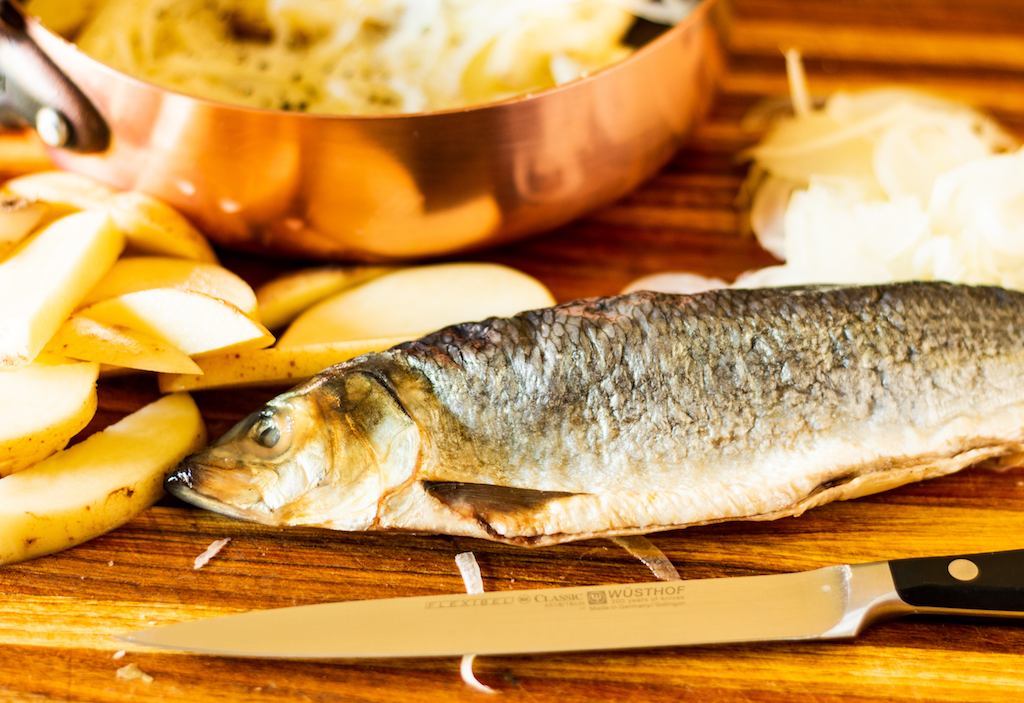We are posting salt herring as a quick, simple preparation that is needed for another dish. History? Long. Fish has been salted for preservation for centuries. The Scandinavians are the modern-day masters of the salt herring, but it was the Dutch who invented a method of curing herring at sea with their secret recipe dating from 1736.
YouTube is awash with handy-looking Americans salting fish in oil-drum quantities. We needed a simple cure for a couple of herring. We simply threw a handful of Maldon sea salt in a vac bag with a gutted fish, sucked the air out and let time do its work. The result is a firm flesh, that still benefits from secondary cooking. The firmness of the fish means that I imagine it would be pretty much amazing in a salad. We made salt herring so we could do the traditional Scottish dish tatties an’ herrin’.
See recipe notes on how to handle this without a vacuum packer.
Salt herring
Ingredients
- 2 whole herring, gutted
- 6 tbsp Maldon sea salt
Instructions
Seal the herring in a bag with the salt. If you have a vac-packer, then use that to get the air out too.
Refrigerate the fish for a week, turning over every day or so.
Open the bag, pour off any fluid and wash the fish briefly under a cold tap.
Bone the fish with a filleting knife – it will be much firmer than filleting a fresh fish. Remove the belly flap and associated bones, but leave the skin on (you will never get it off).
Notes
You can achieve vac pack without a vacuum packer. Place the cure and the target food in a ziplock bag, and lower it into a sink of water until the air is pushed out, but the opening is still clear of the water. Seal.



 (20 votes, average: 4.35 out of 5)
(20 votes, average: 4.35 out of 5)


6 Comments
ashok
22/02/2021 at 7:55 amMy Family Loved it. I am definitely sharing Guys, Thanks For sharing this Great Recipe. this recipe and this website with my friend. Hope they also love it. Thank you again for sharing such a great recipe.
Nigel Eastmond
28/02/2021 at 9:40 pmVery good. This is a peculiar recipe and very old. I am surprised to get a comment on this, but bravo.
Eva Smagacz
06/12/2021 at 3:43 pmVery helpful. Cannot get herring in salt or herring in oil, but our fishmonger has fresh herring. I can do my own now. Perfect
Nigel Eastmond
06/12/2021 at 4:37 pmNo problem. It took a bit of time on YouTube to work out how to do this in any quantity less than “1 barrel.”
Ivan
09/02/2024 at 1:12 pmWhat %age ratio salt to fish are you working on? If you too have little salt, you can poison yourself. Too much, and it tastes horrible. But your quantities are vague. Salt varies in fluffiness, so tbsp has an inconsistent relationship to mass of salt, it can vary by a factor of two. And 2 fish is an even vaguer quantity. For example, when I cure salmon, I work on a minimum safe ratio of 3.5%, a number which I got from a food science book. Before I knew this, and used volumetric measures, I sometimes had a horrible oversalty outcome, and I was dicing with my health.
Nigel Eastmond
09/02/2024 at 7:17 pmThe recipe given here uses Maldon sea salt, which is high-volume flakes. The fish is an adult herring. I am not sure if that answers your question, but that is what I used. The result is a salty as hell, but I then used it in a sub-recipe for tatties and herring, which is where the saltiness and the firmness all makes sense.
Do not kill your kidneys over this – at least not both of them.